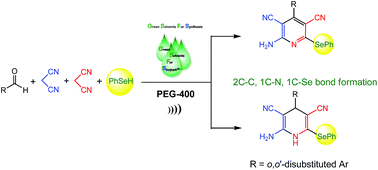Ultrasound assisted multicomponent reactions: a green method for the synthesis of highly functionalized selenopyridines using reusable polyethylene glycol as reaction medium†
Abstract
A simple and benign one-pot protocol for the synthesis of 2-amino selenopyridine derivatives 4 has been developed using ultrasound assisted multicomponent reactions of aldehydes, malononitrile and benzeneselenol in polyethylene glycol (PEG-400). Under similar reaction conditions, sterically hindered o,o′-disubstituted aromatic aldehydes provide the corresponding functionalized seleno dihydropyridines 5. In this process in total four new bonds (two C–C, one C–N and one C–Se) forms in one pot.



 Please wait while we load your content...
Please wait while we load your content...